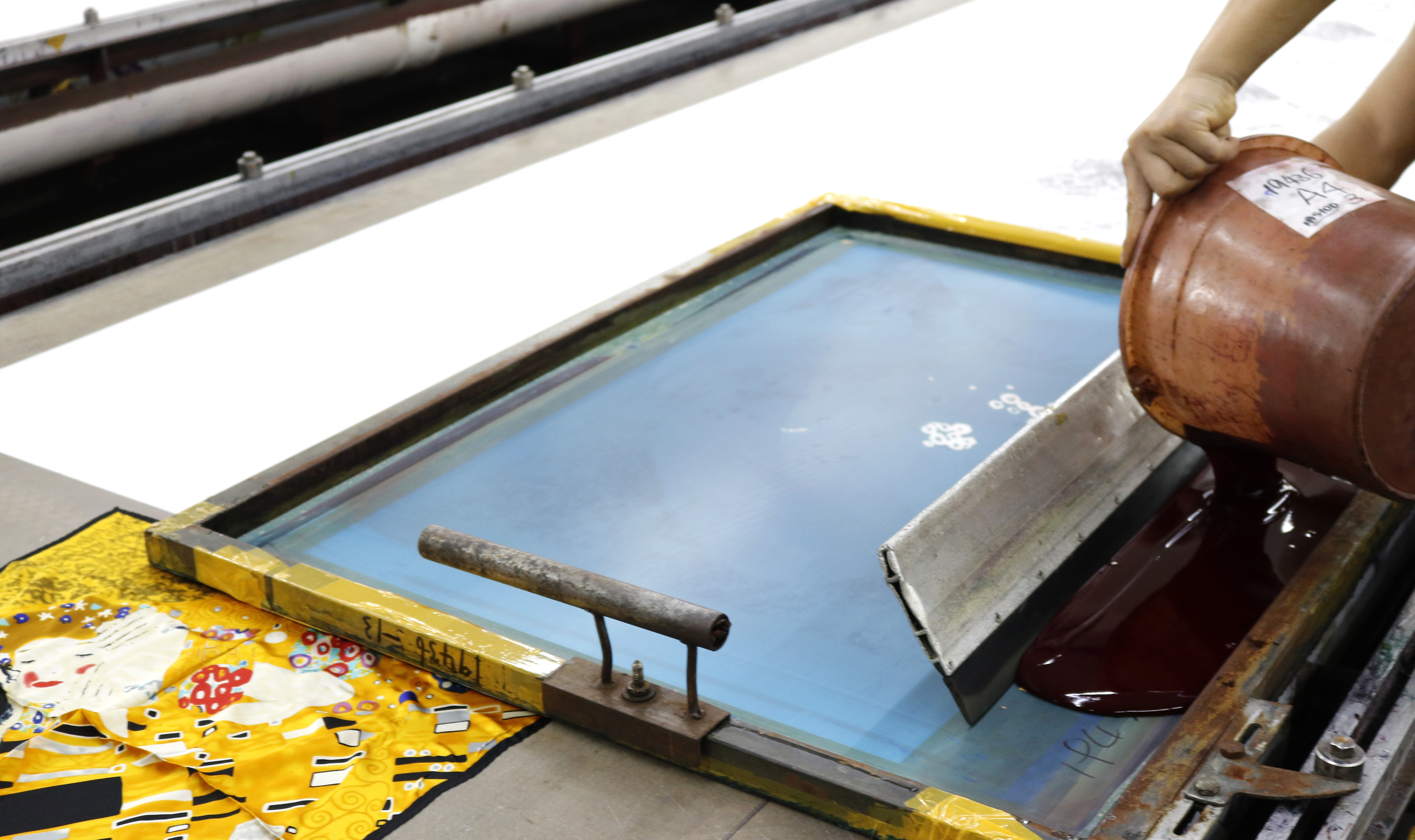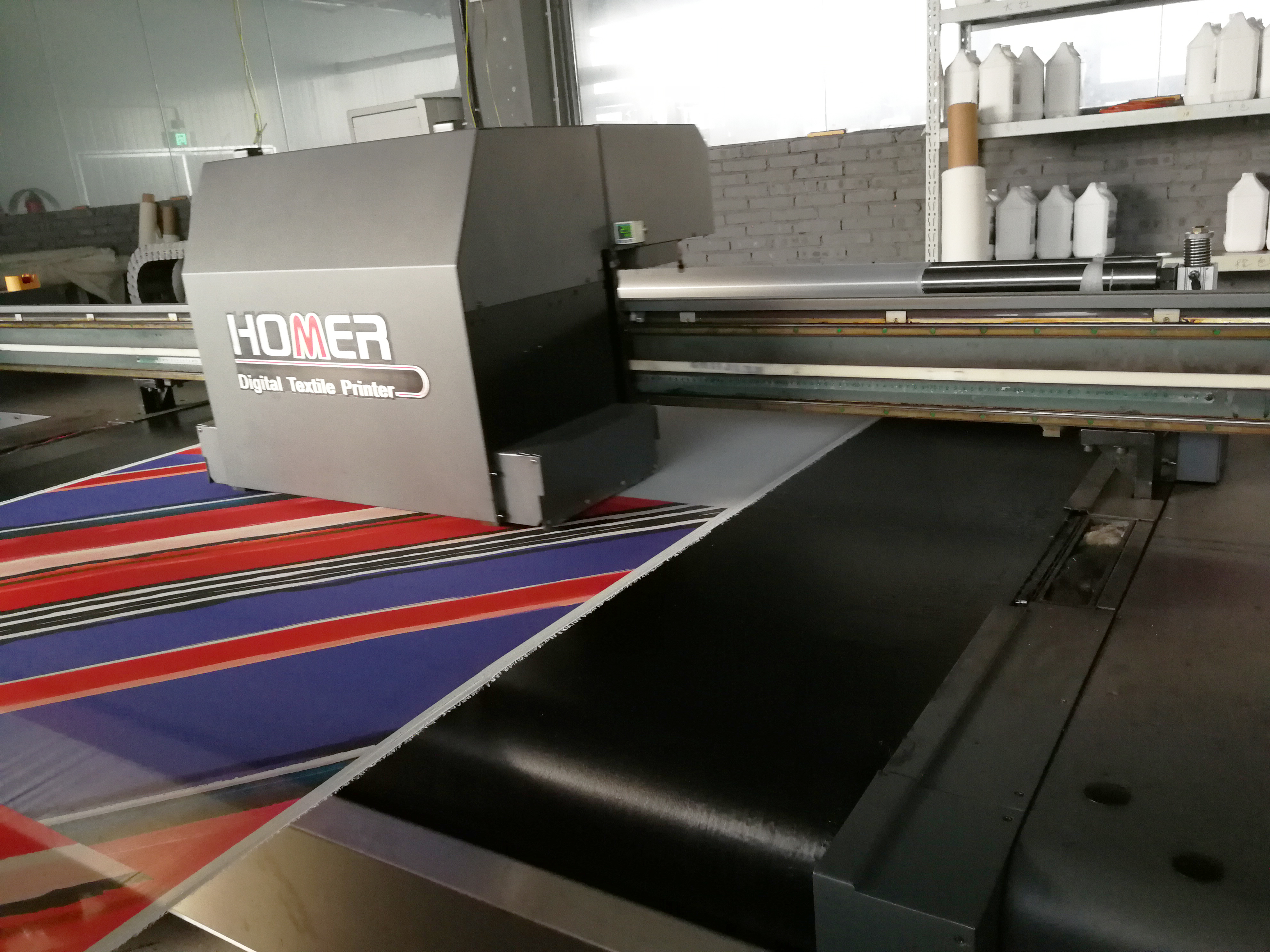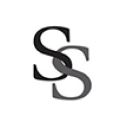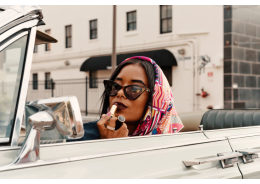Silk printing products have rich patterns, complex patterns, changeable colors, and a wide range of uses. Product development and production cycles are getting faster and faster.
Traditional printing methods have been difficult to meet the rapid development of personalized trends, double-sided digital printing has become an important development direction of silk printing products and gradually replace other printing.
1) Traditional Screen Printing
Most often used for printing silk scarves, since the patterns of silk scarves are mostly flowers and scenery patterns. When the weight of silk scarves is not higher than 50 grams/square meter (14MM) of thin fabrics, hand silk screen printing can make colors similar on both sides. When the silk scarf thickness is above16MM, screen printing can hardly to achieve an excellent penetrating printing effect. The bigger problems for current screen printing factories are that they have to face the production dilemma of high costs for small batches and fewer experienced workers, which cause unstable quality.

2) Traditional Digital Printing
In theory, almost all printing patterns can be realized by traditional digital printing; however, practice shows that, compared with traditional silk printing, traditional digital printing is done by jetting ink droplets. The ink droplets are only attached to the surface of the fabric, which is difficult penetrates into the interior and back of the fabric, and the recoloring is accomplished by the superposition of ink droplets; therefore, single-sided digital printing is not suitable for products that require excellent penetrating printing effects, and the color saturation of the large surface is not as good as the screen printing. Especially the secondary color mixing and the tertiary color mixing still have obvious low-saturation neutral color patches.

When the fabric thickness is less than 12MM, single-sided digital printing can be used to achieve the requirements of front and back penetration printing. The premise is that the resolution of the pattern printing file needs higher pixels, preferably higher than 300DPI, otherwise it is easy to appear jagged edges of the line pattern Shape bleeding, reducing the sharpness of the printed outline of the pattern.
3) Double-sided Digital Silk Printing
When the silk weight is higher than 14MM, the use of single-sided digital printing can't make backside color similar with front. To solve this problem, Double-sided digital printing technology become maturity. There are three options and equipment to choose from. One is the printing two times on both sides of silk fabric, the second is synchronous printing process at different positions, and the third is synchronous printing process at the same position.
(1) Two times double-sided printing: the fabric is pretreated and sizing, after one side of the fabric is printed, the silk fabric will be placed upside down. the pattern on the unprinted side of the fabric is scanned with a laser scanner for precise positioning, and then the other side of the fabric is printed according to the accurate positioning. The core of its technology is laser scanning positioning technology, but the imaging of the laser scanning pattern is related to the thickness of the fabric. For silk fabric less than 19MM, although the pattern can't fully penetrate into the reverse side of silk fabric, but the outline of the pattern on reverse side can still meet the requirements of laser scanning clarity. During the second printing, the scanning probe can still get a clear outline of the pattern, and send it to computer to control the nozzle position to match front side pattern. When the thickness of the silk fabric is higher than 19MM, due to the thickness of the fabric, the pattern on the reverse side of the fabric is not clear, which can't well meet the requirements of laser scanning clarity, the laser can't scan the pattern or the scan pattern has deviations, resulting in inaccurate or difficult positioning when second time printing, especially dots and lines patterns are more prone to inaccurate positioning. The advantage of this printing is that the printing quality is the color is saturated and bright on both sides, and it can print the same pattern with different colors on two sides, or even totally different patterns on two sides.
(2) Synchronous printing on both sides and different positions: First, the fabric is pretreated and sizing, and the front and back sides of the fabric when in contact with the nozzle are changed through the cloth guide device to achieve the effect of simultaneous printing on both sides of the cloth at one time. In addition to relying on precise mechanical transmission and dual nozzle system, the printing device also uses the intermediate drying of the ultraviolet mercury lamp to improve the clarity of the first inkjet printing pattern and prevent the slurry from being squeezed by the guide roller. . The advantage of this method of printing is that the printing effect is the same as single-sided inkjet, and the color is saturated. However, in the secondary printing process of the fabric, the traction generated by the fabric guide device on the warp direction of the fabric can cause the fabric to stretch and deform, causing the patterns of the secondary printing to not overlap; this method is not suitable for fabrics with elasticity such as elastic silk satin, otherwise the print position of the front and rear nozzles will be different.
(3) Two-sided simultaneous printing at the same position: Firstly, the fabric is pretreated and sizing, and two sets of nozzle inkjet systems are set on both sides of the vertical running direction of the silk fabric, and the front and back sides of the fabric are printed at the same time to achieve simultaneous printing at the same position. Because the two sets of nozzles move at the same time, the printing positions are the same and accurate, and the patterns on both sides of the textile are completely overlapped. The printing quality is high and the printing efficiency is improved. From the perspective of the precise pattern overlap on the front and back of the fabric, it is currently the most suitable synchronous printing method for double-sided printing on silk, and the thicker the fabric, the better the printing effect. However, because the inkjet running direction is perpendicular to the fabric, the requirements for the silk fabric pretreatment agent are relatively high, such as the smoothness of the fabric surface (including the edge of the fabric) and the moisture absorption and moisture retention of the fabric surface. Otherwise, Due to the suspension of the nozzle, the ink droplets will jump slightly and flow downwards, resulting in defective printing. In addition, when the silk fabric weight is less than 10MM, the thickness of the sizing layer formed by the fabric sizing pretreatment needs to be controlled to prevent the printing quality problems caused by the excess ink. The printing speed of this method is low, about 12 meters per hour, and the economic efficiency is low. Its disadvantage is that it can't perform well when printing different colors on two sides, two different inks at same time on two sides will mixed to create different colors that not expected.
In view of the increase in labor costs and the continuous improvement of double-sided digital printing technology, traditional printing methods have tended to be eliminated and will eventually be replaced.





 English
English German
German French
French Russian
Russian Spanish
Spanish Japanese
Japanese Korean
Korean Portuguese
Portuguese Ukrainian
Ukrainian Arabic
Arabic Italian
Italian











Leave A Comment